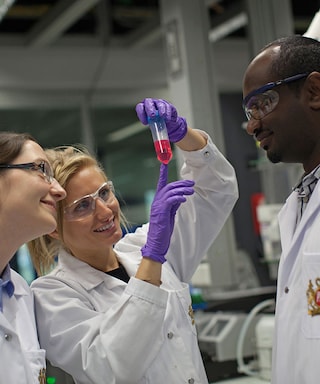Remove the smoke, reduce the exposure to potentially harmful chemicals
Public health data highlights smoking as the leading cause of preventable deaths in the U.S. PMI U.S. is dedicated to changing this reality and is committed to help end smoking.
The U.S. Food & Drug Administration (FDA) and the Center for Tobacco Products (CTP) published an article in 2017 stating, “Nicotine, though not benign, is not directly responsible for the tobacco-caused cancer, lung disease, and heart disease that kill hundreds of thousands of Americans each year. The FDA’s approach to reducing the devastating toll of tobacco use must be rooted in this foundational understanding: Other chemical compounds in tobacco, and in the smoke created by combustion, are primarily to blame for such health harms.”
Eliminating combustion dramatically reduces the levels of harmful chemicals, which is the cornerstone of smoke-free product development. Smoke-free products are not risk-free and remain addictive, but can offer taste, ritual, sensation, and nicotine levels comparable to cigarettes for those adults who otherwise would continue to smoke.
The science behind smoke-free alternatives to end smoking in the U.S.
Dr. Mathew R. Holman, Vice President & Chief Scientific & Regulatory Strategy Officer, U.S., Philip Morris International, speaks to camera:
“My hope is that one day, the United States is smoke-free.”
Gentle rhythmic music plays in the background for the rest of the video.
Text says “A scientific assessment of smoke-free innovations”
Dr. Holman continues: “The science on the harms on the harms from smoking have been evident for decades. However, there are still about 28 million in the United States. They know that smoking’s harmful. What they don’t understand is that there are different levels of harm produced by different tobacco products. Cigarettes are the most harmful for of nicotine consumption. What happens when you burn tobacco is that it creates all these different chemicals in that burning process. And unfortunately, many of those chemicals are toxic.”
Graphic appears with the title “Tobacco risk reduction” showing a steep descent in risk as it moves from combustion to no combustion.
Dr. Holman continues: “If we can really encourage smokers that exist in the United States today to move away from combusted tobacco products to any other non-combusted tobacco product, any other smoke-free product. If we focused on the science and that began all of our conversations, man, the progress we’d make.
As the chief scientist at FDA Center for Tobacco Products, I was able to look at the science around these products and authorize products that would give options to smokers to switch to another tobacco product that would significantly reduce their exposure to toxicants.”
Infographic with the title “Eliminate the burning, reduce the harm.” On one side under the word cigarette, it says “Burns tobacco. Smoke. Ash. High levels of harmful and potentially harmful chemicals.” On the other side under the words “Smoke-free alternative” it says “Does not burn tobacco. Aerosol. No ash. Significantly lower levers of harmful and potentially harmful chemicals” with an asterisk which says “Smoke-free products are not risk free and are addictive. The benefits described above should be substantiated on a case-by-case basis. The best choice a smokers can make is to quit cigarettes and nicotine completely.”
Dr. Hollman continues: “Misconceptions are running rampant amongst current tobacco product users. But I think what would surprise a lot of people to know is that they’re also running rampant across the medical community. Our health care providers, the people that we all trust to go to for advice of how to improve our health and well-being have significant misunderstandings about tobacco products. 60 percent of health care providers in the United States believe that all tobacco products have the same risk. That is absolutely not true. I believe we all, all stakeholders in this space, have an obligation to correct that misperception. We all have a responsibility, whether you’re a regulator, whether you’re a public health organization, whether you’re industry, to do as much as we can to eliminate deaths caused from smoking every year in the United States because it’s completely preventable.”
Text says: “If you don’t smoke, don’t start. If you smoke, quit. If you don’t quit, change.”
The Philip Morris International logo appears.

Clearing up confusion around smoke-free products could create huge benefits for public health. The fact is, FDA-authorized, innovative smoke-free products do exist, and they have the power to drive real change toward accelerating an end to smoking.”
Nicotine facts
While nicotine is addictive and not risk-free, its role in smoking-related diseases is often misunderstood, even in the medical community. A 2020 report indicated that more than 80 percent of physicians wrongly agreed that nicotine contributes directly to both the development of lung cancer and COPD.
Here is what the roughly 30 million adult smokers in the United States—and their physicians—need to know about nicotine.
Nicotine can raise the heart rate and blood pressure and should not be used by people with certain health conditions such as pregnant women or those with heart disease or diabetes—but, again, it’s not the primary cause of smoking-related diseases. Smoking-related diseases are principally caused by the high levels of harmful chemicals in tobacco smoke.
Roberto & Josephine, Smoker and daughter, Miami, FL
Alea, smoker, Atlanta, GA
Choice and the need for a range of alternatives
The best choice is to quit or never to begin using tobacco or nicotine products, and every year, many people successfully do quit. But, for those adults who continue smoking, there is another option–scientifically substantiated smoke-free alternatives are a measurably better choice than continued smoking.
Recent decades have seen an innovative move from high-risk combustible products (such as cigarettes, cigars, and pipe tobacco) to smoke-free alternatives (such as vapes, heated tobacco products, snus, and oral nicotine pouches), offering better alternatives to adults who otherwise would continue to smoke.
According to U.S. public health data, while more than half of adult smokers report having made a quit attempt in the past year, less than one in 10 succeed. Each smoker’s journey to a better alternative is unique.
A wide range of smoke-free options offers an alternative path for adults who don’t quit, by empowering them to make a better choice than continuing to smoke.
Policy and action need to follow science’s lead
The FDA can help end smoking faster by prioritizing the regulatory review of smoke-free tobacco product applications that could be labeled as modified risk due to reduced exposure to toxicants or reduced risk of disease. But regulation isn’t the only thing within the power of the FDA. So, too, is public communication.
While the FDA advances public health by helping to speed innovations that make drugs, products, and devices safer, they also have a responsibility to share accurate and science-based information so people can choose to make better decisions for their health.
Since smoke-free alternatives exist, the FDA can and should do more to make this information readily available. Smoke-free products do not burn tobacco and while not risk-free, can significantly reduce the levels of toxicants produced compared to cigarettes. Adults who smoke deserve to know how alternative products differ from cigarettes.



